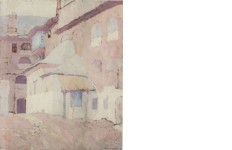TITLEMOUNT ATHOS, FROM KARYES
MEASUREMENTS (cm)Height : 33
Width : 27.2
USED MATERIALSOil painting (Oil on cardboard)
SIGNATURELower Right
CHRONOLOGY
AUTHENTICITY CHECKNot checked

Footnotes
Painted in 1923.
PROVENANCE:
Private collection, Athens.
Bathed in ethereal light, Karyes, Mount Athos captures the feeling of peace and serenity which has been the Holy Mountain's greatest single benediction for well over a thousand years. One almost believes that the complex architecture of the monastic compound, barely emerging from a field of pink and violet hues, is loosing its structural integrity. Dematerialized, as if wanting to reach the heavens, this view of Karyes no longer represents a specific place but reflects the infinite from whence ideal forms originate. As noted by the director of the National Gallery in Athens M. Lambraki-Plaka, "Papaloukas' expertly trained eye reveals the 'eternal becoming' of the world."1
Karyes, Mount Athos was painted during the artist's stay in the Holy Mountain in 1923-1924 accompanied by his close friend Stratis Doukas. After roaming the peninsula for a year and having amassed an impressive collection of material, he retreated to a cell in Karyes and prepared for a major showing which opened in Thessaloniki's White Tower in 1924 and met with great success. This output, ranking among the greatest and most enduring achievements of Modern Greek art, is a key chapter not only in the development of the painter's style but also in the evolution of early 20th century Greek art. As noted by art historian A. Kouria, "with these works Papaloukas provided a composed and daring answer to some of the period's foremost issues, including those related to tradition and the nation's self knowledge."2
One of the first to tackle Greekness in relation to the pursuits of modern art, Papaloukas engaged in a thorough study of the underlying principles of Byzantine art, which culminated in his work on Mt. Athos. As noted by Athens National Gallery Director M. Lambraki-Plaka, the artist's decision to go to the Holy Mountain had a dual significance. He sought consolation, a cleansing from the recent Asia Minor tragedy, but also had the chance to formulate his own view on a balanced approach to tradition. He sought not to imitate or revive the Byzantine tradition but, rather, to capture the very essence of the Greek past as a continuous cultural entity from ancient times to Byzantium to the modern era.3
1. See M. Lambraki-Plaka, 'Papaloukas' Painting' in Spyros Papaloukas, Painting 1892-1957 [in Greek], Athens 1995, pp. 33-48.
2. A. Kouria, 'Spyros Papaloukas' Athos' in Spyros Papaloukas, Apprenticing in Mt. Athos [in Greek], Athos 2003, p. 22.
3. Lambraki-Plaka, 'Papaloukas' Painting, a Spiritual Adventure' [in Greek] in Spyros Papaloukas, exhibition catalogue, B&M Theocharakis Foundation for the Fine Arts and Music, Athens 2009, p. 14.